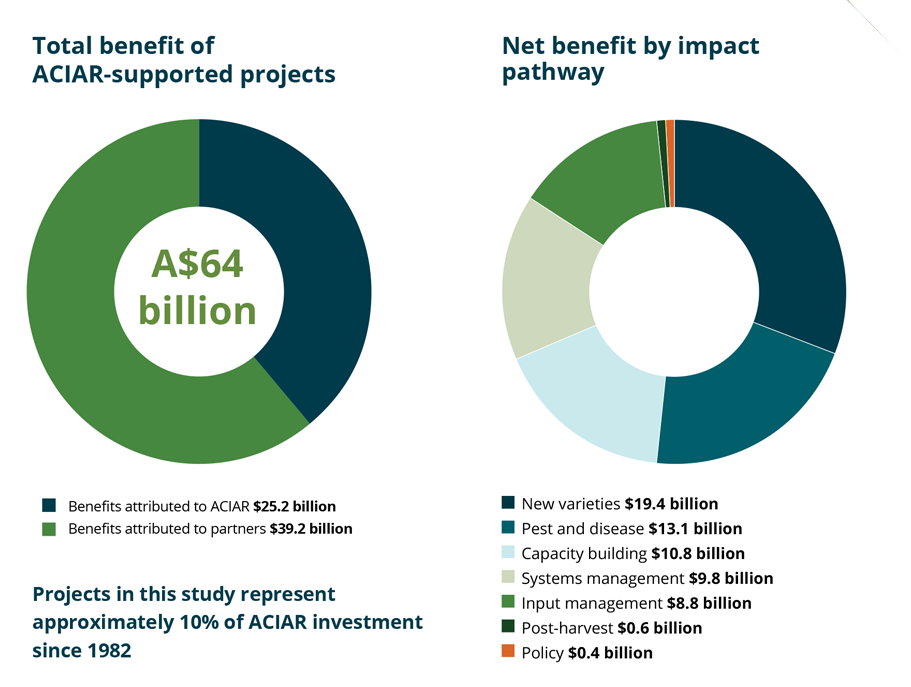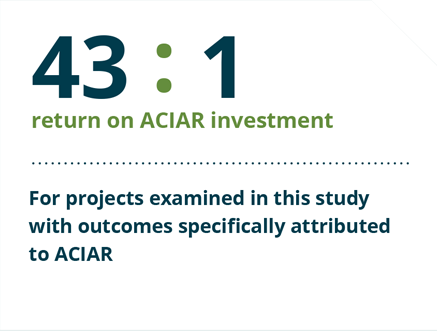40 years of impact
Over 40 years, the Australian Centre for International Agricultural Research (ACIAR) has made a significant contribution to meeting the complex challenges of growing more food, reducing poverty and improving biosecurity. Confidence in making such a claim is underpinned by a longstanding program of impact evaluation.
From the first economic evaluations of project outputs in the early 1990s, through to a well-established program of impact assessment and outcome evaluation in the 2020s, ACIAR has always demonstrated the effectiveness of its work in terms of economic, knowledge and capacity benefits to smallholder farmers and science institutions in partner countries. A rigorous impact evaluation program also enables accountability to the Australian Government and the Australian public for the use of public funds on agricultural research for development.
Leading up to the Sunset Review of ACIAR that was scheduled to take place in 1994, as directed by the founding legislation, an external panel was appointed to undertake a ‘mid-term review’ of ACIAR in 1989. In its report to ACIAR, the panel provided 24 recommendations. One was ‘that ACIAR initiate a process of defining the criteria on which its own success should be judged, and that studies to this end should be related to the wider implications of impact assessment in the context of international agricultural research generally’.
A series of studies was commissioned to assess the impact of research results stemming from selected ACIAR projects and a report was published in 1991, 9 years after the establishment of ACIAR. The benefits of agricultural research can take many years to be realised – improvements in productivity may be incremental, and are frequently dependent on behavioural, social and regulatory change.
While the studies were considered ‘early days’ in terms of measuring impact, they did provide a solid indication that benefits well in excess of research costs were starting to emerge in partner countries.
It was also anticipated that the studies would show projects that did not yield the expected economic benefits. Such cases would provide an opportunity to identify and analyse the underlying factors influencing project outcomes, providing crucially important ‘lessons learned’, which can be drawn upon for planning and developing new projects.
In 1998, it was decided that studies of impact assessment would be published as a publicly available series – the Impact Assessment Series. The first impact assessment report published was ‘Control of Newcastle disease in village chickens’, based on three projects funded between 1983 and 1996. From the outset, it was acknowledged that not all benefits would be quantifiable, as the conclusions of the assessment report highlighted.
Australia’s reputation in the international scientific community has been enhanced and there has been considerable international cooperation as a result of this work. Supply of the I-2 virus seed stock to developing countries free of charge is undoubtedly appreciated by recipient countries. Through this work there are also opportunities to strengthen the role of women in poor village communities.
ACIAR Impact Assessment No. 1, 1998
The processes of assessment and evaluation of ACIAR investments have changed with time, as organisational learning and experience in impact assessment grew and new methods of evaluation developed.
Leading up to its 40th year, ACIAR commissioned both a quantitative and qualitative assessment of the impact of selected research since 1982. The 40-year milestone was an ideal opportunity to understand what ACIAR-supported research has achieved and to reflect on what has been learned from the organisation’s lifetime of brokering and funding agricultural research partnerships in the Indo-Pacific region.
The study was published, in two volumes, as the 100th report in the Impact Assessment Series, ‘The impact of ACIAR work in agricultural research for development 1982–2022’.
The quantitative analysis of projects represented approximately 10% of ACIAR investment in research partnerships over 40 years.
- The total benefit of projects examined in the study was estimated at A$64.4 billion.
- A$25.2 billion of benefit can be attributed to ACIAR, based on the ACIAR share of total project funding; the remainder was attributed to partner funding.
- The benefit:cost ratio of the research in which ACIAR is a partner, on average, is 41.8:1.
- For outcomes specifically attributed to ACIAR, the benefit:cost ratio is 43.3:1.
The qualitative analysis was based on a large cross-case analysis of past projects. Recognising that not all impacts can be crystallised in production numbers or financial returns, the study applied qualitative comparative analysis to identify the key research design, management and practice principles that have supported the effective translation of research knowledge into development outcomes.
The analyses identified 24 unique pathways towards successful project outcomes, which were grouped into five distinct clusters. Each cluster highlights the unique point of difference of ACIAR within the aid program and profiles the contribution ACIAR has made in certain areas. The clusters identified were:
- Theory and practice of change
- Classic agricultural research-for-development project
- Scaling out
- Scaling up
- Pure or basic science.
In recent years, in line with global concerns about the impact of development assistance on such issues, it [ACIAR] has broadened its impact assessment studies to investigate the impacts of its projects on poverty and on the environment. ACIAR has been proactive in pushing for improvements in the methodology and in extending its scope. In all of this work, ACIAR can be justly proud of being a world leader.
Independent Review of ACIAR 2013 by Mr Bill Farmer, Prof Ron Duncan, Mr Terry Enright and Dr Wendy Jarvie
The total benefit

